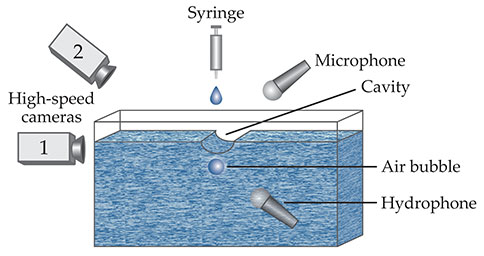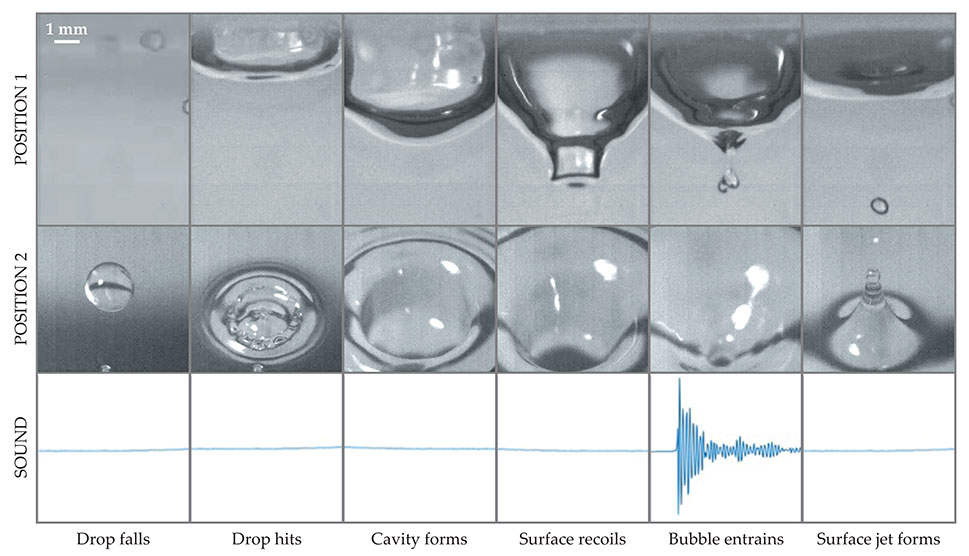The annoying dripping tap
DOI: 10.1063/PT.3.4100
Whether produced by a leaky tap dripping into a sink or by raindrops falling onto a lake, the distinctive and at times irritating plink of a small drop falling into a larger body of liquid has been the subject of scientific curiosity for more than a century. In 1989 Hugh Pumphrey and colleagues determined that the source of the sound is a pulsating air bubble trapped under the surface of the water during the drop impact. However, until recently it was not clear just how the underwater bubble produces the plink heard above water by the human ear. In this Quick Study we describe a project that took advantage of devices unavailable to Pumphrey to better understand how the bubble generates its characteristic sound.
The pulsating air bubble
Figure
Figure 1.

An artificial tap. In our experiment to analyze the sound of a dripping tap, we dropped water into a small fish tank, viewed the process with two high-speed cameras, and listened with a microphone above the water surface and a hydrophone below it.

Figure
Figure 2.

Development and aftermath of a plink. Views from below the water surface (position 1) and above the surface (position 2) show that a drop hitting a water surface is a multistage process. Only the bubble entrainment, however, produces an audible sound registered by the above-water microphone.

The sound signals recorded at each stage, shown below the high-speed video frames in the figure, confirm the finding by Pumphrey and his team that the characteristic plink sound is produced at the instant the air bubble becomes trapped under the water surface. Every other aspect of the impact process is silent, never mind that a drop impact results in all manner of splashes and ripples. That’s a truly extraordinary result, but in retrospect not unexpected. The splashes, ripples, and jet flung into the air by the recoiling cavity are moving far too slowly to produce an acoustic signal.
After demonstrating that air-bubble entrainment is key to sound production, Pumphrey and colleagues suggested that the pulsations of the trapped bubble, kick-started by the violent pinch-off of the surface cavity, were the cause of the plink. Indeed, as early as 1933, Marcel Minnaert had suggested that pulsating bubbles cause the sound of falling drops and running water, and he derived a formula showing that the natural frequency of a pulsating underwater bubble is inversely proportional to its diameter. With that formula in hand, we used our high-speed video frames to determine the size of the entrained bubble in one of our experiments and found its theoretical pulsation frequency to be 7.9 kHz. The measured frequency of the sound was 8.6 kHz. Such a 10% discrepancy is to be expected, given that the bubble is not perfectly spherical, as was assumed by Minnaert; that it is close to and interacts with the tank surface; and that deducing the size of a three-dimensional bubble from two-dimensional video frames introduces its own error. (See also the Quick Study by Kyle Spratt, Kevin Lee, and Preston Wilson, Physics Today, August 2018, page 66
The oscillating water surface
The entrained air bubble drives the characteristic plink sound, but how? Underwater, the answer is simple: The pulsating bubble emanates sound waves that travel unimpeded through the water to the hydrophone, which records the plink. It’s less evident how the pulsating bubble drives a sound field that reaches the human ear above the water. One possibility, consistent with elementary calculations based on plane waves, is that the sound waves emanated in the water by the pulsating bubble propagate directly through the water surface.
We conducted a simple experiment to test the idea. The key to the observations was a phenomenon that’s usually a problem in acoustic experiments with a small tank: sound reverberation from reflections off the tank walls. Such reverberation can contaminate the acoustic signals we record, and to reduce it, we lined our fish tank with wood. But we also ran trials without the wood lining and compared the two cases. We found that the underwater sound signature changed significantly; wood lining removed the amplifications due to reverberation. The airborne sound signature, however, was not affected by the wood. If the underwater sound field were merely propagating through the water surface to produce the sound heard above, then eliminating the reverberation would have the same effect on both sound fields. After all, the airborne sound field should just be an attenuated form of the underwater one. The simple reverberation experiment demonstrated that such is not the case. Moreover, the attenuation we measured was much less than would be expected for simple propagation across the water surface.
Instead, we suggest, the crucial idea behind the generation of airborne sound is that the pulsating bubble itself drives oscillations of the water surface at the bottom of the cavity. The water surface thus acts like a loudspeaker and pushes sound waves into the air at the same frequency as the pulsating air bubble that drives the motion of the cavity bottom. The pulsating bubble is not a perfectly efficient driver; the amplitude of the sound wave emanating into the air from the water surface is smaller than the amplitude of the sound emitted into the water by the bubble. By modeling the surface motion at the bottom of the cavity as a piston, we were able to calculate the relative pressure of the above-water and underwater sound fields. Our predicted value was in good agreement with the experimental values we measured.
Our project was mainly curiosity driven, but its findings nonetheless have potential applications. Pumphrey and company’s work was motivated by the idea that if a link could be found between the frequency of a plink and the size of the drop that produces it, then investigators might be able to use audio recordings to measure oceanic rainfall rates. Herman Medwin and colleagues, among others, have made progress toward realizing that vision, but an accurate measurement tool has yet to be established, and additional work is necessary. A better understanding of the sound-production mechanism could also be useful for the video-game and film industries. Although many types of sounds used in video games and films are synthetically generated, the industries still rely on audio recordings to re-create the complex sound of drips and rainfall. Finally, we have neared completion of a follow-up study to explore whether pulsating underwater bubbles are also crucial to understanding the sounds of running water, as Minnaert suspected long ago.
References
► H. C. Pumphrey, L. A. Crum, L. Bjørnø, “Underwater sound produced by individual drop impacts and rainfall,” J. Acoust. Soc. Am. 85, 1518 (1989). https://doi.org/10.1121/1.397353
► M. Minnaert, “On musical air bubbles and the sounds of running water,” London, Edinburgh, Dublin Philos. Mag. J. Sci. 16, 235 (1933). https://doi.org/10.1080/14786443309462277
► H. Medwin et al., “The anatomy of underwater rain noise,” J. Acoust. Soc. Am. 92, 1613 (1992). https://doi.org/10.1121/1.403902
► S. Phillips, A. Agarwal, P. Jordan, “The sound produced by a dripping tap is driven by resonant oscillations of an entrapped air bubble,” Sci. Rep. 8, 9515 (2018). https://doi.org/10.1038/s41598-018-27913-0
► T. G. Leighton, The Acoustic Bubble, Academic Press (2012).
More about the Authors
Sam Phillips is a student at the University of Cambridge in the UK, where Anurag Agarwal is a reader in acoustics and biomedical technology in the department of engineering. Peter Jordan is a CNRS researcher at the Pprime Institute in Poitiers, France.







